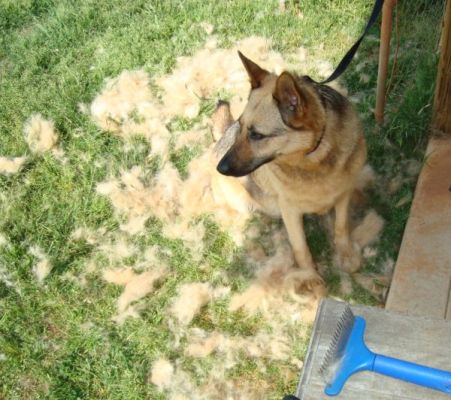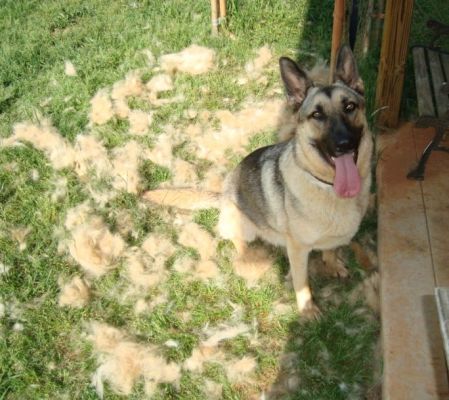
This is a placeholder text
Group text
by Anthony1565 on 04 June 2013 - 18:06
by Anthony1565 on 04 June 2013 - 19:06
about 75% less.
by Ruger1 on 04 June 2013 - 21:06
 ......
......by Kalibeck on 05 June 2013 - 13:06
by guddu on 05 June 2013 - 14:06
by Red Sable on 05 June 2013 - 14:06

by LadyFrost on 05 June 2013 - 15:06
not much at all.....just enough to make it look like its Christmas time all over again...LOL
( i raked fur after each dog...at the end had enough fur to make a dog bed..LOL)


by WhollyHund on 05 June 2013 - 15:06
I brush my 2-year-old Shepherd almost every day, and get a carrier-bag full every time - if I don't gather it all up, it looks like the garden is being taken over by Tribbles!
Even with the constant brushing, there are still herds of dust bunnies under the furniture... just the nature of our hairy beasts, I'm afraid. Interesting to take note of the two people who mention supplements - worth looking into if it reduces the Tribble population!
Rob
by Blitzen on 05 June 2013 - 16:06
Dog shedding can be frustrating for all of us, no matter how much we love our dogs. The mess of dog hair can be enough to drive dog owners nuts. All dogs shed to some degree, with the exception of completely hairless dogs. Certain breeds (so-called hypoallergenic dogs) shed very little, while others (namely heavily double-coated breeds) shed large amounts.
Year-Round Shedding
All animals with hair shed on a regular basis. This is part of the natural life cycle of hair shafts within the follicles. All hair shafts go through phases of growth and shedding. The phases affect the rate of hair growth and will vary by breed, age, hormones, environment and overall health of the dog. These factors also contribute to the length and texture of the hair, though genetics is the predominant factor. Dogs with continuously growing hair, like Poodles and Yorkshire Terriers, have hair shafts with longer life spans and therefore shed very little. On the other hand, dogs like Labradors and Huskies, have a shorter hair shaft life span and more abundant undercoats, resulting in greater shedding.Shedding Season
In general, most dogs will shed extra during Spring and Fall. Dogs are double-coated, meaning they have undercoats. These are secondary hairs that occur around the primary hairs and tend to be shorter and softer. Seasonal shedding occurs as a result of temperature change. This process is often called "blowing coat." When the weather warms, dogs shed their old winter undercoats to make way for a lighter summer coat. Then, when it begins to get cool again, dogs shed their lighter undercoats and grow a thicker, warmer coat for winter. Not all coat types are affected the same way by temperature changes. For example, dogs like Bichons and Shih Tzus have very little undercoat and therefore shed less when seasons change. However, dogs like Newfoundlands and Malamutes have heavy, thick undercoats that make shedding much more obvious.
Other Reasons for Shedding
Your dog's health can affect shedding rate, so it is important to take note of unexplained excessive shedding. Skin problems, endocrine diseases, nutritional or vitamin deficiencies, and other metabolic disorders can cause hair loss or change the rate of hair growth. It is important to contact your veterinarian if you are concerned about the rate of shedding in your dog. Keep your dog healthy with routine vet visits and proper nutrition. Contact your vet immediately if you notice any signs of illness.Get Control Over Shedding
There's no way to completely stop shedding. It's a healthy process that is necessary for all dogs. Shaving your dog down is not a good idea, as it can interfere with your dog's natural self-cooling and self-warming mechanism. In the long run, it will not make shedding any less. The key to preventing excess shedding is to keep up with it. Routine grooming is absolutely essential. Brushing or combing your dog helps to remove dead hairs before they can fall on your carpet, bedding and upholstery. It will prevent those dead hairs from forming mats on your dog's coat that can eventually harm the skin. Brushing also distributes the natural, healthy oils produced by the skin throughout the hair coat. Using the right grooming tools can make a great difference. For heavy shedders, a special shedding tool like the FURminator can work wonders.
Managing the Aftermath of Shedding in Your Home
Shedding makes a mess, there is no doubt about that. As a dog owner, you have most likely come to terms with the fact that regular housecleaning is the norm, especially during shedding season. The key is to remove hair before it has a chance to embed itself into your carpet and upholstery. Keeping a pet hair tape roller around for touch-ups throughout the day is an excellent idea. For deeper cleaning of upholstery and small areas, consider using a handheld vacuum designed to pick up pet hair, like the Dyson DC31 Animal. When it comes to cleaning carpets, Panasonic's Pet-Friendly JetSpin Cyclone does the job well. For non-carpeted floors, some excellent options include the Swiffer, the Fur-Be-Gone Broom and similar style products.
by Sunsilver on 05 June 2013 - 17:06
A Swiffer pad would be toast in this house with just a couple of swipes of the floor! I've also found out the cleaning solution they use is NOT pet-friendly!
There's a good reason Cesar Millan no longer endorses this product!!

I'll stick with my mop and broom thank you very much! I REALLY wish they'd take those stupid ads off TV!
Contact information Disclaimer Privacy Statement Copyright Information Terms of Service Cookie policy ↑ Back to top




